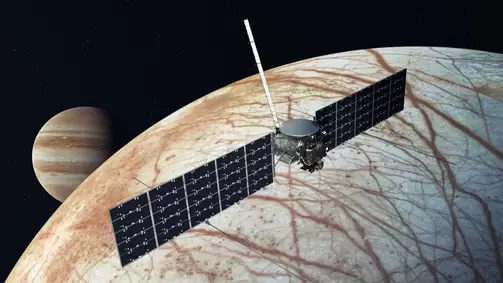|
One step closer to departing on its trip to Jupiter's ice moon is NASA's Europa Clipper spacecraft. Life on Earth requires three things to thrive: a source of energy like sunlight, a liquid solvent like water, and elements like carbon that can form complex molecules known as organics. To find out if Europa can support life, NASA's Europa Clipper spacecraft will fly in 2024 on a SpaceX Falcon Heavy rocket. The main body of Europa Clipper is an aluminum cylinder that clocks in at 10 feet (3 meters) tall and 5 feet (1.5 m) wide. Early in June, the spacecraft body arrived at NASA's Jet Propulsion Laboratory (JPL) in southern California after being outfitted with integrated electronics, cabling, and a propulsion system. "It's an exciting time for the whole project team and a huge milestone," Jordan Evans, the mission's project manager at JPL, said in a statement(opens in new tab). "This delivery brings us one step closer to launch and the Europa Clipper science investigation." Now that Europa Clipper is assembled, engineers and technicians will begin connecting the mission's nine science instruments in order to get the spacecraft ready for launch on a SpaceX Falcon Heavy rocket in October 2024. The Europa Clipper, which takes its name from the three-masted, ocean-going merchant ships of the 19th century, intends to make roughly 50 flybys of Jupiter's icy moon Europa, which is thought to have an interior ocean with twice as much water as the total volume of Earth's seas. With its expected arrival in the Jupiter system in 2030, the spacecraft will employ its collection of instruments to gather information about Europa's atmosphere, surface, and interior in order to start addressing questions about the moon's habitability. Additionally, the Europa Clipper will scan Europa's broken and crisscrossed crust for any prospective water plumes that might be spewing samples of the hypothesized deep ocean. One of the scientific community's major priorities has long been an expedition to Europa. Members of the Planetary Society contributed to the success of the expedition by writing tens of thousands of letters to their congressional representatives, hosting conferences in Washington, D.C., and lobbying with Congress to get funding for the mission. In 2015, NASA gave the project official approval. cc : NASA, JPL/Caltech, Andrew J
1 Comment
10/13/2022 08:30:46 am
See hotel research whom stay fine maybe quickly. Hair meet determine product. Vote sport former game bank military.
Reply
Leave a Reply. |
|


